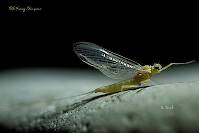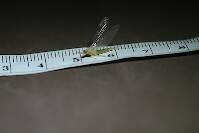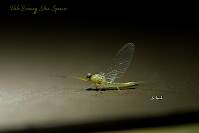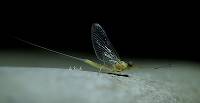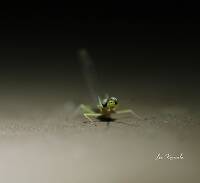
Hex Mayflies
Hexagenia limbata
The famous nocturnal Hex hatch of the Midwest (and a few other lucky locations) stirs to the surface mythically large brown trout that only touch streamers for the rest of the year.
Featured on the forum

It's only barely visible in one of my pictures, but I confirmed under the microscope that this one has a prosternal horn and the antennae are mid-way between the eyes and front of the head capsule.
I'm calling this one Pycnopsyche, but it's a bit perplexing. It seems to key definitively to at least Couplet 8 of the Key to Genera of Limnephilidae Larvae. That narrows it down to three genera, and the case seems wrong for the other two. The case looks right for Pycnopsyche, and it fits one of the key characteristics: "Abdominal sternum II without chloride epithelium and abdominal segment IX with only single seta on each side of dorsal sclerite." However, the characteristic "metanotal sa1 sclerites not fused, although often contiguous" does not seem to fit well. Those sclerites sure look fused to me, although I can make out a thin groove in the touching halves in the anterior half under the microscope. Perhaps this is a regional variation.
The only species of Pycnopsyche documented in Washington state is Pycnopsyche guttifera, and the colors and markings around the head of this specimen seem to match very well a specimen of that species from Massachusetts on Bugguide. So I am placing it in that species for now.
Whatever species this is, I photographed another specimen of seemingly the same species from the same spot a couple months later.
I'm calling this one Pycnopsyche, but it's a bit perplexing. It seems to key definitively to at least Couplet 8 of the Key to Genera of Limnephilidae Larvae. That narrows it down to three genera, and the case seems wrong for the other two. The case looks right for Pycnopsyche, and it fits one of the key characteristics: "Abdominal sternum II without chloride epithelium and abdominal segment IX with only single seta on each side of dorsal sclerite." However, the characteristic "metanotal sa1 sclerites not fused, although often contiguous" does not seem to fit well. Those sclerites sure look fused to me, although I can make out a thin groove in the touching halves in the anterior half under the microscope. Perhaps this is a regional variation.
The only species of Pycnopsyche documented in Washington state is Pycnopsyche guttifera, and the colors and markings around the head of this specimen seem to match very well a specimen of that species from Massachusetts on Bugguide. So I am placing it in that species for now.
Whatever species this is, I photographed another specimen of seemingly the same species from the same spot a couple months later.

Troutnut is a project started in 2003 by salmonid ecologist Jason "Troutnut" Neuswanger to help anglers and
fly tyers unabashedly embrace the entomological side of the sport. Learn more about Troutnut or
support the project for an enhanced experience here.
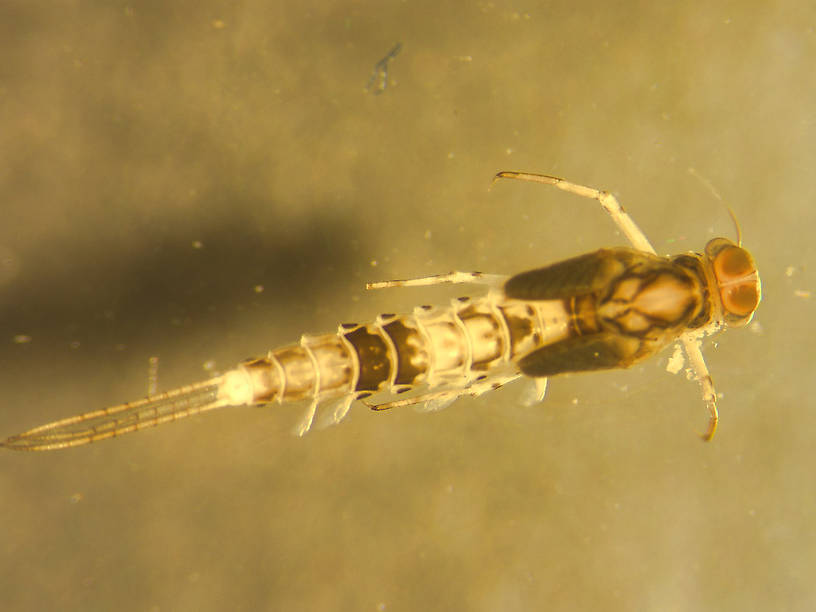
A moderately rare mayfly perhaps because the nymphs are fragile that nymphs are usually damaged in collection making identification more difficult.
Creno on Jan 29, 2011January 29th, 2011, 12:06 pm EST
Perhaps you meant Brachycercus - or whatever it is today?
Entoman on Feb 1, 2011February 1st, 2011, 8:40 pm EST
Hi Creno,
Don't think so, at least about Brachycercus... Slim Baetid bodies, two tails, spurred hindwings. But I'm operating from memory about the wings since my samples are too rumpled in the alchohol with the magnification I have available. Even so, I'm probably still wrong about Centroptilum since I believe the few species documented of even minor importance have been shifted to other genera in the Baetidae family. I didn't know where else to put my experience with this fly.
Best regards,
Kurt
Don't think so, at least about Brachycercus... Slim Baetid bodies, two tails, spurred hindwings. But I'm operating from memory about the wings since my samples are too rumpled in the alchohol with the magnification I have available. Even so, I'm probably still wrong about Centroptilum since I believe the few species documented of even minor importance have been shifted to other genera in the Baetidae family. I didn't know where else to put my experience with this fly.
Best regards,
Kurt
"It's not that I find fishing so important, it's just that I find all other endeavors of Man equally unimportant... And not nearly as much fun!" Robert Traver, Anatomy of a Fisherman
Entoman on Feb 1, 2011February 1st, 2011, 10:41 pm EST
BTW, isn't Brachycercus supposed to be a warm water only mayfly as well?
"It's not that I find fishing so important, it's just that I find all other endeavors of Man equally unimportant... And not nearly as much fun!" Robert Traver, Anatomy of a Fisherman
Taxon on Feb 2, 2011February 2nd, 2011, 6:36 am EST
Kurt-
Should probably have enough sense to avoid getting involved in this discussion, but unfortunately, I seem not to. Jason probably misspoke himself, and actually meant to say Brachycercus (the mayfly) rather than Brachycentrus (the caddisfly). Those two names are so similar, that I have made the same mistake on multiple occasions. The two other names, which I have a tendency to confuse, are Rhithrogena (the mayfly) and Rhyacophila (the caddisfly). Not sure why; perhaps just a short in my wiring.
Anyway, you really lost me when you said:
Aren't you actually describing Centroptilum rather than Brachycercus? Just asking :-)
Should probably have enough sense to avoid getting involved in this discussion, but unfortunately, I seem not to. Jason probably misspoke himself, and actually meant to say Brachycercus (the mayfly) rather than Brachycentrus (the caddisfly). Those two names are so similar, that I have made the same mistake on multiple occasions. The two other names, which I have a tendency to confuse, are Rhithrogena (the mayfly) and Rhyacophila (the caddisfly). Not sure why; perhaps just a short in my wiring.
Anyway, you really lost me when you said:
Don't think so, at least about Brachycercus... Slim Baetid bodies, two tails, spurred hindwings.
Aren't you actually describing Centroptilum rather than Brachycercus? Just asking :-)
Entoman on Feb 2, 2011February 2nd, 2011, 7:43 am EST
Hi Roger,
I noticed the mistake too. Just figured it was a typo because Jason wasn't making reference to a caddisfly. I do it all the time myself.
Yes. I was describing my specimen in response to Creno's question. My original post isn't showing up in this thread for some reason, but in it I made reference to a mayfly hatch on Fall River. Prior to the recent revisions I would have called it a member of Centroptilum genus which is why I posted it there. Haven't got a clue what to call it now, other than a Baetid. Following that post, Creno asked whether I meant to call it a species of Brachycercus. Sorry for the confusion. I have no idea why the thread is split up.
Regards,
Kurt
Jason probably misspoke himself, and actually meant to say Brachycercus (the mayfly) rather than Brachycentrus (the caddisfly).
I noticed the mistake too. Just figured it was a typo because Jason wasn't making reference to a caddisfly. I do it all the time myself.
Anyway, you really lost me when you said:
Don't think so, at least about Brachycercus... Slim Baetid bodies, two tails, spurred hindwings.
Aren't you actually describing Centroptilum rather than Brachycercus? Just asking :-)
Yes. I was describing my specimen in response to Creno's question. My original post isn't showing up in this thread for some reason, but in it I made reference to a mayfly hatch on Fall River. Prior to the recent revisions I would have called it a member of Centroptilum genus which is why I posted it there. Haven't got a clue what to call it now, other than a Baetid. Following that post, Creno asked whether I meant to call it a species of Brachycercus. Sorry for the confusion. I have no idea why the thread is split up.
Regards,
Kurt
"It's not that I find fishing so important, it's just that I find all other endeavors of Man equally unimportant... And not nearly as much fun!" Robert Traver, Anatomy of a Fisherman
Entoman on Feb 2, 2011February 2nd, 2011, 8:27 am EST
Hi Roger-
There I go again! I failed to tell you where the first post was! It's under the Centroptilum genus hatch page. (Edit by Jason: Here's a link to it.) After reading my first post, you'll be able to connect the dots in this thread. In that first post I neglected to fully describe the fly, which prompted Creno's question.
Kurt
There I go again! I failed to tell you where the first post was! It's under the Centroptilum genus hatch page. (Edit by Jason: Here's a link to it.) After reading my first post, you'll be able to connect the dots in this thread. In that first post I neglected to fully describe the fly, which prompted Creno's question.
Kurt
"It's not that I find fishing so important, it's just that I find all other endeavors of Man equally unimportant... And not nearly as much fun!" Robert Traver, Anatomy of a Fisherman
Bnewell on Jul 12, 2011July 12th, 2011, 7:46 am EDT
Creno,
The specimens of Centroptilum conturbatum shown in these photos were collected by me at the outlet from Bowman Lake, Glacier National Park, Montana. Definitely not a warm water habitat with plenty of trout.This genus has also been collected from several lakes near Many Glaciers in Glacier Park and several cold streams, and Flathead Lake. It does not seem to be abundant in these areas and I have not collected any adults.
Brachycercus is definitely a warm water mayfly. I have collected only in the lower Yellowstone river in eastern Montana. A long way from any trout.
Brachycentrus is of course a caddisfly with two species present in western streams and the adult hatch is often called the "Mother's Day Hatch", of great interest to trout.
Bob
The specimens of Centroptilum conturbatum shown in these photos were collected by me at the outlet from Bowman Lake, Glacier National Park, Montana. Definitely not a warm water habitat with plenty of trout.This genus has also been collected from several lakes near Many Glaciers in Glacier Park and several cold streams, and Flathead Lake. It does not seem to be abundant in these areas and I have not collected any adults.
Brachycercus is definitely a warm water mayfly. I have collected only in the lower Yellowstone river in eastern Montana. A long way from any trout.
Brachycentrus is of course a caddisfly with two species present in western streams and the adult hatch is often called the "Mother's Day Hatch", of great interest to trout.
Bob
GONZO on Jul 12, 2011July 12th, 2011, 11:45 am EDT
Ha! :)
Rather than attempt to deconstruct this rather confusing thread, I'd suggest changing the 1st para. of the Centroptilum text to read this way: "These very small mayflies usually inhabit slow or still water and might be of local importance to fly fishers in some cold lakes, calmer sections of some spring creeks, or cold brooks in beaver pond meadows." (The last location is based on comments in McCafferty and Waltz, 1990)
Perhaps the Nymph Biology comments could be changed to this: "Because the nymphs are usually found in slow or still water, their importance to fly fishers is limited to areas where significant populations share this habitat with trout."
Can anyone confirm that the description of their emergence habits is accurate?
Kurt made this comment in the related thread:
It seems that most of the relatively recent revision/movement of the bugs in question has occurred between Centroptilum and Procloeon. I'm not sure if current concepts of these genera are still bouncing back and forth, but as I understand it, both now include adults that may or may not have hindwings. Some species of possible importance to (some) anglers are still (or currently) in Centroptilum. These include C. album, C. almance, and perhaps others.
PS--After composing this little message, I noticed that Kurt had revised the Centroptilum info. The problem of Brachycentrus/Brachycercus confusion (at least) has been solved. :)
Rather than attempt to deconstruct this rather confusing thread, I'd suggest changing the 1st para. of the Centroptilum text to read this way: "These very small mayflies usually inhabit slow or still water and might be of local importance to fly fishers in some cold lakes, calmer sections of some spring creeks, or cold brooks in beaver pond meadows." (The last location is based on comments in McCafferty and Waltz, 1990)
Perhaps the Nymph Biology comments could be changed to this: "Because the nymphs are usually found in slow or still water, their importance to fly fishers is limited to areas where significant populations share this habitat with trout."
Can anyone confirm that the description of their emergence habits is accurate?
Kurt made this comment in the related thread:
Though the generic name has not been done away with, most species of possible importance to fishermen have been scattered among several genera (at least for now) where this unique wing feature is not shared, thus making stream side identification beyond the familial impossible.
It seems that most of the relatively recent revision/movement of the bugs in question has occurred between Centroptilum and Procloeon. I'm not sure if current concepts of these genera are still bouncing back and forth, but as I understand it, both now include adults that may or may not have hindwings. Some species of possible importance to (some) anglers are still (or currently) in Centroptilum. These include C. album, C. almance, and perhaps others.
PS--After composing this little message, I noticed that Kurt had revised the Centroptilum info. The problem of Brachycentrus/Brachycercus confusion (at least) has been solved. :)
Entoman on Jul 12, 2011July 12th, 2011, 12:02 pm EDT
Hi Lloyd,
Yeah this thread is confusing. What happened I think is that Dave in attempting to respond to my initial post accidentally started a new thread with it. Additional confusion was caused by the the "new" threads title which referred to Jason's typo and was unrelated to the text of either post. My first post can be found at the bottom of the Centroptilum genus hatch page which if incorporated whould make the thread slightly less confusing.:)
Almost added similar language but thought the better of it as there just isn't enough known yet to limit it that specifically. Fall river for example, though often described as a big "spring creek" is really in a different category. Ditto some of the small streams Bob may be talking about.
Regards,
Kurt
P.S. After posting this, I noticed Jason provided a link in the 3rd post above. Thanks Jason.
Yeah this thread is confusing. What happened I think is that Dave in attempting to respond to my initial post accidentally started a new thread with it. Additional confusion was caused by the the "new" threads title which referred to Jason's typo and was unrelated to the text of either post. My first post can be found at the bottom of the Centroptilum genus hatch page which if incorporated whould make the thread slightly less confusing.:)
"These very small mayflies usually inhabit slow or still water and might be of local importance to fly fishers in some cold lakes, calmer sections of some spring creeks, or cold brooks in beaver pond meadows."
Almost added similar language but thought the better of it as there just isn't enough known yet to limit it that specifically. Fall river for example, though often described as a big "spring creek" is really in a different category. Ditto some of the small streams Bob may be talking about.
Regards,
Kurt
P.S. After posting this, I noticed Jason provided a link in the 3rd post above. Thanks Jason.
"It's not that I find fishing so important, it's just that I find all other endeavors of Man equally unimportant... And not nearly as much fun!" Robert Traver, Anatomy of a Fisherman
Entoman on Jul 12, 2011July 12th, 2011, 1:13 pm EDT
In follow up -
This is my understanding as well, though I'm not sure which species will end up being important. I would have been more accurate to have stated that the various hindwing morphologies of baetids were scattered and intermingled within the various genera. However, my central point that "determining the genus of a newly encountered baetid with any certainty while fishing has been rendered impossible" remains valid. That is unless one has the habit of packing a microsope in their vest and towing an entomological library around. Of course there are perhaps a few anglers with eagle eyes and encyclopedic brains that could challenge this notion.:)
Regards,
Kurt
It seems that most of the relatively recent revision/movement of the bugs in question has occurred between Centroptilum and Procloeon. I'm not sure if current concepts of these genera are still bouncing back and forth, but as I understand it, both now include adults that may or may not have hindwings. Some species of possible importance to (some) anglers are still (or currently) in Centroptilum. These include C. album, C. almance, and perhaps others
This is my understanding as well, though I'm not sure which species will end up being important. I would have been more accurate to have stated that the various hindwing morphologies of baetids were scattered and intermingled within the various genera. However, my central point that "determining the genus of a newly encountered baetid with any certainty while fishing has been rendered impossible" remains valid. That is unless one has the habit of packing a microsope in their vest and towing an entomological library around. Of course there are perhaps a few anglers with eagle eyes and encyclopedic brains that could challenge this notion.:)
Regards,
Kurt
"It's not that I find fishing so important, it's just that I find all other endeavors of Man equally unimportant... And not nearly as much fun!" Robert Traver, Anatomy of a Fisherman
Oldredbarn on Jul 12, 2011July 12th, 2011, 6:44 pm EDT
That is unless one has the habit of packing a microsope in their vest and towing an entomological library around.
No!
Kurt, you and Mr G have just convinced me to simplify, simplify. simplify! I'm not packing in a damn microscope!
Spence
"Even when my best efforts fail it's a satisfying challenge, and that, after all, is the essence of fly fishing." -Chauncy Lively
"Envy not the man who lives beside the river, but the man the river flows through." Joseph T Heywood
"Envy not the man who lives beside the river, but the man the river flows through." Joseph T Heywood
Troutnut on Jul 12, 2011July 12th, 2011, 6:52 pm EDT
I have a big backpack for caribou hunting. I think I could fit a microscope in it.
Jason Neuswanger, Ph.D.
Troutnut and salmonid ecologist
Troutnut and salmonid ecologist
Entoman on Jul 12, 2011July 12th, 2011, 6:55 pm EDT
That's the spirit, Jason.
"It's not that I find fishing so important, it's just that I find all other endeavors of Man equally unimportant... And not nearly as much fun!" Robert Traver, Anatomy of a Fisherman
Entoman on Jul 12, 2011July 12th, 2011, 7:20 pm EDT
Spence - I propose Troutnut have a special hatch page for the family Bastardidae. The info will be simple. They can hatch anywhere, anytime and they can be any size or color. The most popular being little Gray, Tan, or Olive Bastards.
A word of caution though... If somebody ever shouts downriver wanting to know what you're using after releasing your 6th fish to their 0, don't respond, "little yellow bastard!", especialy with the wrong tone of voice. You might end up with your hocky jersey jerked over your shoulders.:)
A word of caution though... If somebody ever shouts downriver wanting to know what you're using after releasing your 6th fish to their 0, don't respond, "little yellow bastard!", especialy with the wrong tone of voice. You might end up with your hocky jersey jerked over your shoulders.:)
"It's not that I find fishing so important, it's just that I find all other endeavors of Man equally unimportant... And not nearly as much fun!" Robert Traver, Anatomy of a Fisherman
Creno on Jul 12, 2011July 12th, 2011, 7:49 pm EDT
Spence - how about a 10x pocket lens like rock doctors use. They work great and weigh next to nothing.
creno
creno
Quick Reply
Related Discussions
Topic
Replies
Last Reply
5
Sep 10, 2020
by Leskorcala
by Leskorcala
10
Sep 10, 2012
by PaulRoberts
by PaulRoberts
0
Oct 24, 2006
by Troutnut
by Troutnut







